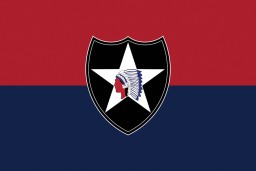<< Previous | Displaying results 2401-2450 of 2604 for "" | Next >>
-
A group of Tunisian schoolgirls
PhotoA group of Tunisian schoolgirls wearing aprons. Nadia Cohen is in the first row, third from the left. Tunis, Tunisia, ca. 1930-1935. Nadia Cohen was born on January 17, 1924, in Tunis. Nadia's parents came from Orthodox households, but her father left the yeshiva at the age of seven to study Italian, Arabic, and accounting in a French school. In 1938, Nadia was sent to a boarding school in France. She returned home for a visit in the summer of 1939 but could not return to school that fall due to the…
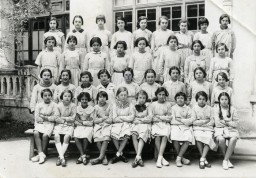
-
Prewar photograph of Terese Cohen with her two children
PhotoTerese Cohen, a Tunisian Jewish women, poses with her two children, Nadia and Marcel. Immediately after the Allied landings in Algeria and Morocco, the Germans occupied Tunisia. After the occupation, an SS officer came to the Cohen's house and confiscated everything leaving only the table and chairs for the Germans to use. They gave the family 24 hours to pack and leave and then expropriated the home to use as a barracks for soldiers.

-
Forced labor in Tunisia
PhotoAs a German soldier looks on, Tunisian Jews are forced to sweep the street and move a wooden crate on a hand cart. Tunisia, 1942-43. Photograph courtesy of Bundesarchiv, German Federal Archives
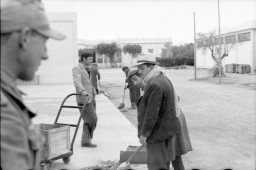
-
Forced labor in Im Fout labor camp
PhotoSami Dorra working at dam construction in the Im Fout labor camp. The camp was approximately 59 miles southwest of Casablanca, and housed a group of foreign workers. Im Fout, Morocco, 1941-42.
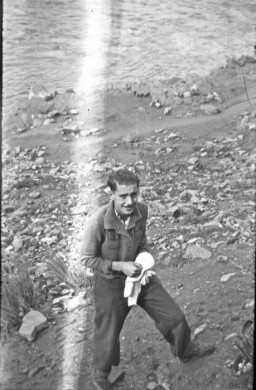
-
Im Fout labor camp
PhotoAn unidentified worker walks by the railroad tracks at the Im Fout labor camp in Morocco. Living conditions were harsh in the camp, and many of the workers fell ill with typhus. Im Fout, Morocco, 1941-42.
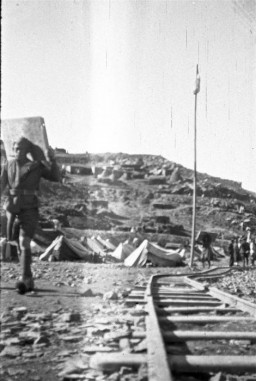
-
Construction of a dam near the Im Fout labor camp
PhotoView of the dam being built by forced laborers from the Im Fout labor camp in Morocco. Photograph taken 1941-42.
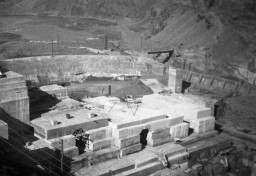
-
A German Jewish prisoner at forced labor in the Im Fout camp
PhotoA German Jewish prisoner named Rosenthal pushes a cart in the stone quarry of the Im Fout labor camp in Morocco. The camp housed a group of foreign workers, many of whom fell ill because of poor living conditions. Im Fout, Morocco, 1941-42.

-
Two prisoners in the Im Fout labor camp
PhotoClose-up portrait of two prisoners in the Im Fout labor camp in Morocco. The camp was approximately 59 miles southwest of Casablanca, and housed a group of foreign workers. Many of the prisoners fell ill because of poor living conditions in the camp. Im Fout, Morocco, 1941-42.

-
Jewish children study in a Hebrew school in Casablanca
PhotoThis photo was taken during the journey of Bluma (Kleinhandler) and Zygmunt Godzinski from Poland to Argentina. Casablanca, Morocco, 1946.
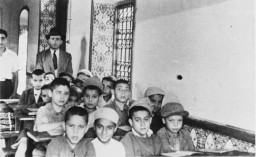
-
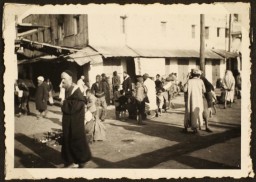
-
Ayindram Betar summer camp in Tunisia
PhotoChildren stand at attention during a flag raising ceremony at the Ayindram Betar summer camp. Tunisia, North Africa, 1946.

-
African American soldiers pose in the Ebensee camp
PhotoAfrican American soldiers pose next to an oven in the crematorium of the Ebensee concentration camp.
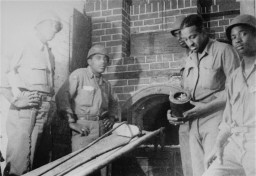
-
HIAS immigration certificate
PhotoHIAS immigration certificate issued to Manius Notowicz in Munich, Germany. The document states that Notowicz will travel on the Marine Flasher on February 22, 1947, to New York City.
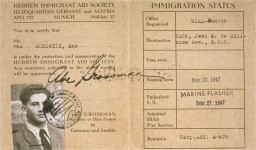
-
Orchestra in the Janowska camp
PhotoMembers of the orchestra at the Janowska concentration camp perform while standing in a circle around the conductor in the Appelplatz [roll call area]. Pictured at the right, in the light uniform, is camp commandant Warzok Franz. The Janowska orchestra included some of the leading Jewish musicians in Lvov, among them violinist Leonid Stricks and cellist Leon Eber. The SS forced the orchestra to perform during selections and actions and even "commissioned" a special composition to be played on these…

-
Pastor Martin Niemöller
PhotoPastor Martin Niemöller speaks to reporters after his release from a concentration camp. Germany, 1945.

-
Youth at vocational training in Kloster Indersdorf
PhotoThe Kloster Indersdorft displaced persons camp opened in July 1945. By mid-September, 1945, 192 boys and girls from thirteen nations, including 49 Jewish children, were sheltered at Kloster Indersdorf, more than double what had been anticipated. Over the next year, the numbers increased to over 300. Five hours each day were allocated to education. Teachers were drawn from the staff as well as the local community. Many of the children had few or no literacy skills; they also benefitted from art, music,…
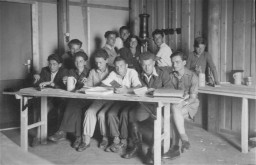
-
Identification card issued to Oskar Russ in the Feldafing displaced persons' camp
PhotoIdentification card issued to Oskar Russ in the Feldafing displaced persons' camp. Oskar Russ was born in Poland in 1907. During the Holocaust, he was imprisoned in the Dachau concentration camp. After liberation, he was in the Feldafing displaced persons camp before immigrating in 1947 to the United States with his wife (whom he had married in Feldafing).
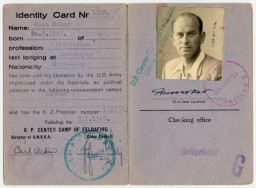
-
Portrait of Rabbi Shimon Huberband
PhotoPortrait of Rabbi Shimon Hoberband, who was involved in the activities of Emanuel Ringelblum's Oneg Shabbat archives in the Warsaw ghetto.
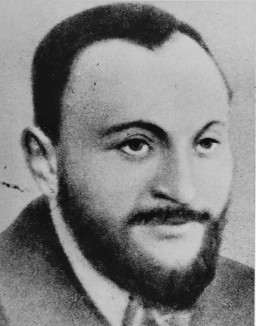
-
Reich Party Day parade
PhotoSpectators cheer passing SA formations during a Reichsparteitag (Reich Party Day) parade in Nuremberg.
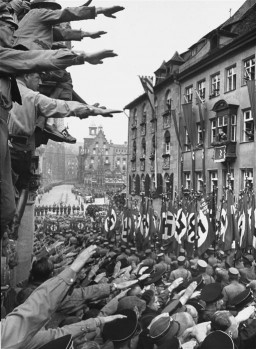
-
Racial identification
PhotoA technician determines the racial makeup of a young woman by the color of her hair.

-
"Degenerate Art" Exhibition
PhotoVisitors view the "Degenerate Art" exhibition (Entartete Kunst) at the Munich Hofgarten in July 1937. Works by Lovis Corinth and Franz Marc are visible, among others.

-
Propaganda slide
PhotoPropaganda slide which contrasts a person of mixed race (left) with a healthy "Aryan" youth (right).
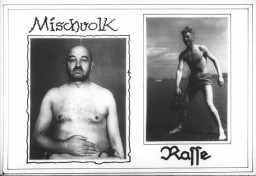
-
Prisoners of the Gestapo
PhotoPrisoners march in the courtyard of the Gestapo headquarters in Nuremberg. The original caption to the photograph reads: "The courtyard of the Gestapo headquarters, Nurnberg. These appear to be Frenchmen taken to Germany as slave laborers".
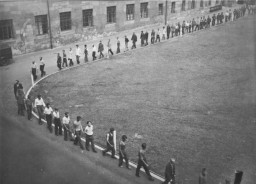
-
Group portrait taken in prewar Warsaw
PhotoGroup portrait of women and children standing outside in Warsaw before the war. Warsaw, Poland, ca. 1938.
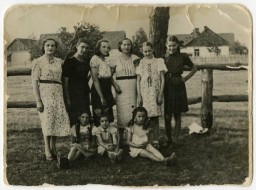
-
Crowd in Berlin during the anti-Jewish boycott
PhotoGermans in front of a Jewish-owned department store in Berlin during the anti-Jewish boycott. Berlin, Germany, April 1, 1933.
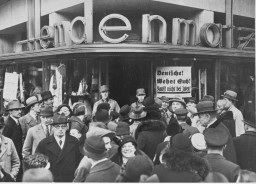
-
Postcard of Evian-les-Bains
PhotoPeriod postcard of Evian-les-Bains, the site of the 1938 International Conference on Refugees.
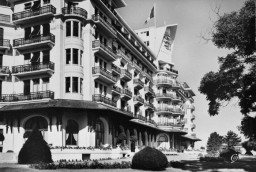
-
Adolf Hitler addresses an SA rally
PhotoAdolf Hitler addresses an SA rally. Dortmund, Germany, 1933.

-
Cordell Hull signs neutrality proclamation
PhotoPortrait of Secretary of State Cordell Hull signing President Franklin D. Roosevelt's neutrality proclamation. September 5, 1939.
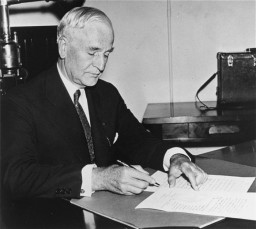
-
Dr. Mohamed Helmy
PhotoPortrait of Dr. Mohamed Helmy. Helmy was an Egyptian physician living in Berlin. He worked together with Frieda Szturmann, a local German woman, to help save a Jewish family.

-
Dr. Mohamed Helmy and Emmi Ernst
PhotoDr. Mohamed Helmy and his wife, Emmi Ernst. During the Nazi era, they were forbidden from marrying because Dr. Helmy was not an Aryan. They were finally able to marry after the end of World War II.
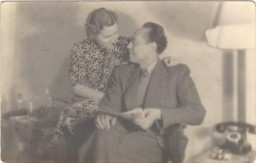
-
Anna Gutman (Boros) visits her rescuer Dr. Mohamed Helmy in 1968
PhotoAnna Gutman (Boros) (left) and her daughter, Carla (second from left), visit with Dr. Mohamed Helmy (second from right) and his wife, Emmi (right), in Berlin in 1968. Dr. Helmy hid Gutman in his home for the duration of World War II.
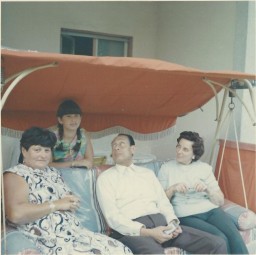
-
Anna Gutman (Boros) visits her rescuer Dr. Mohamed Helmy in 1980
PhotoAnna Gutman (Boros) (seated, center), her daughter, and son-in-law visit Dr. Mohamed Helmy (seated, left) and his wife, Emmi (seated, right), in Berlin in 1980. Dr. Helmy hid Gutman in his home for the duration of World War II.
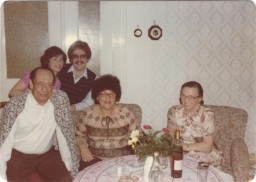
-
Freedom of Press
Photo(1941-1942) Crowded newsstands in the United States such as these held journals representing various political parties and ideologies. Americans had access to many different perspectives about what was happening at home and abroad during the war.
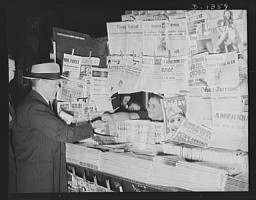
-
German tanks during Operation Barbarossa
PhotoGerman tanks pass a burning Russian village during Operation Barbarossa, the invasion of the Soviet Union, in the summer of 1941. © IWM (HU 111382)
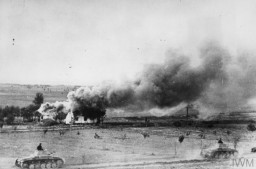
-
Horst Wessel leads his SA formation through the streets
PhotoHorst Wessel leads his SA formation through the streets of Nuremberg during the fourth Nazi Party Congress in August 1929.

-
Women’s Suffrage in Weimar-era Germany
PhotoA crowd stands outside of a polling center in Berlin during the German national election in January 1919. This was the first election held under the Weimar Republic (1918–1933), as well as the first election in which women had the legal right to vote in Germany. Women's suffrage was declared in Germany only a couple of months earlier, on November 12, 1918. © IWM Q 110868
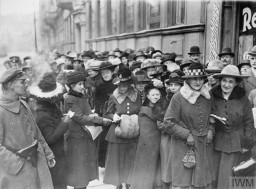
-
Call for Jews to fight antisemitism in prewar Hungary
PhotoThis photo shows a placard urging Hungarian Jews to unite against rising antisemitism in prewar Hungary and Europe. It rallies Jews to protest, using such phrases as: "Protect Jewish honor!”; “Do not buy from our enemies!”; and “Do not watch movies from the Third Reich." Hungary, 1937.
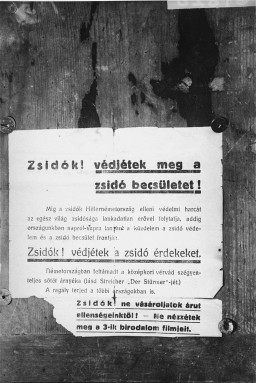
-
World War I armistice, November 1918
PhotoThe armistice that ended the hostilities of World War I was signed in a railcar in the Forest of Compiègne. The railcar belonged to French Marshal Ferdinand Foch, the commander of the victorious Allied forces. © IWM Q 61172
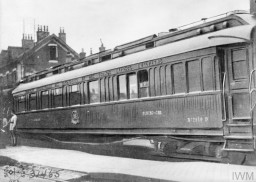
-
Flag graphic for the US 101st Airborne Division
PhotoA digital representation of the United States 101st Airborne Division's flag. The US 101st Airborne Division (the "Screaming Eagles" division) was established in 1942. During World War II, they were involved in D-Day and the Battle of the Bulge. The division also captured the city of Eindhoven and uncovered the Kaufering IV camp. The 101st Airborne Division was recognized as a liberating unit in 1988 by the United States Army Center of Military History and the United States Holocaust Memorial Museum…

-
Flag graphic for US 103rd Infantry Division
PhotoA digital representation of the United States 103rd Infantry Division flag. The US 103rd Infantry Division (the "Cactus" division) was established in 1942. During World War II, they were involved in the Battle of the Bulge and captured the city of Innsbruck. The division also uncovered a Nazi subcamp attached to Kaufering camp complex. The 103rd Infantry Division was recognized as a liberating unit in 1985 by the US Army's Center of Military History and the United States Holocaust Memorial Museum…
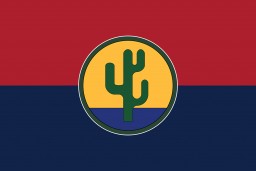
-
Flag graphic for US 104th Infantry Division
PhotoA digital representation of the United States 104th Infantry Division's flag. The US 104th Infantry Division (the "Timberwolf" division) was activated in 1942. During World War II, they captured the cities of Cologne and Halle. The division also overran Nordhausen and the Dora-Mittelbau concentration camp. The 104th Infantry Division was recognized as a liberating unit in 1988 by the United States Army Center of Military History and the United States Holocaust Memorial Museum (USHMM).
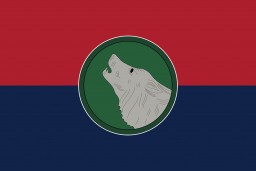
-
Flag graphic for US 10th Armored Division
PhotoA digital representation of the United States 10th Armored Division's flag. The US 10th Armored Division is also known as the "Tiger" division. During World War II, they captured the cities of Trier and Oberammergau. The division also overran a Dachau subcamp. The 10th Armored Division was recognized as a liberating unit in 1985 by the United States Army Center of Military History and the United States Holocaust Memorial Museum (USHMM).

-
Flag graphic for US 11th Armored Division
PhotoA digital representation of the United States 11th Armored Division's flag. The US 11th Armored Division (the "Thunderbolt" division) was formed in 1942. During World War II, they were involved in the Battle of the Bulge and captured the cities of Coburg, Bayreuth, and Linz. The division also overran the Mauthausen and Gusen concentration camps. The 11th Armored Division was recognized as a liberating unit in 1985 by the United States Army Center of Military History and the United States Holocaust…
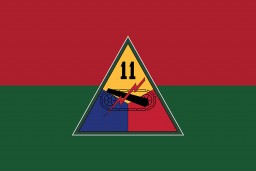
-
Flag graphic for US 12th Armored Division
PhotoA digital representation of the United States 12th Armored Division's flag. The US 12th Armored Divison is also known as the "Hellcats" division. During World War II, they captured the cities of Ludwigshafen and Würzburg. The division also overran a subcamp of Dachau. The 12th Armored Division was recognized as a liberating unit in 1988 by the United States Army Center of Military History and the United States Holocaust Memorial Museum (USHMM).
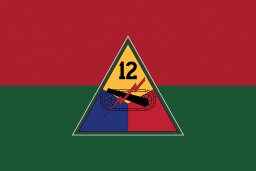
-
Flag graphic for US 14th Armored Division
PhotoA digital representation of the United States 14th Armored Division's flag. The US 14th Armored Division (the "Liberators" division) joined the war in 1944. During World War II, they uncovered several subcamps of Dachau, three large forced-labor camps, and several other nearby camps. The 14th Armored Division was recognized as a liberating unit in 1991 by the United States Army Center of Military History and the United States Holocaust Memorial Museum (USHMM).
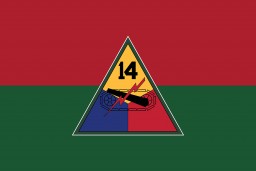
-
Flag graphic for US 1st Infantry Division
PhotoA digital representation of the United States 1st Infantry Division's flag. The US 1st Infantry Division (the "Big Red One" division) was formed in 1917 and fought in World War I. During World War II, they were involved in the Allied invasions of North Africa and Italy, as well as D-Day and the Battle of the Bulge. Additionally, the division captured the city of Aachen and liberated Zwodau and Falkenau an der Eger, two subcamps of Flossenbürg. The 1st Infantry Division was recognized as a liberating…

-
Flag graphic for US 20th Armored Division
PhotoA digital representation of the United States 20th Armored Division's flag. The US 20th Armored Division was occasionally known as the "Armoraiders" during World War II. They participared in the liberation of the Dachau concentration camp. The 20th Armored Division was recognized as a liberating unit in 1985 by the United States Army Center of Military History and the United States Holocaust Memorial Museum (USHMM).
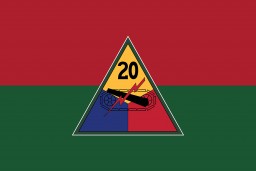
-
Flag graphic for US 26th Infantry Division
PhotoA digital representation of the United States 26th Infantry Division's flag. The US 26th Infantry Division (the "Yankee" division) was formed in 1917 and fought in World War I. During World War II, they were involved in the Battle of the Bulge and captured the city of Linz. The division also overran the Gusen concentration camp. The 26th Infantry Division was recognized as a liberating unit in 2002 by the United States Army Center of Military History and the United States Holocaust Memorial Museum…
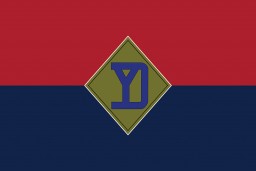
-
Flag graphic for US 29th Infantry Division
PhotoA digital representation of the United States 29th Infantry Division's flag. The US 29th Infantry Division (the "Blue and Gray" division) was established in 1917 and fought in World War I. During World War II, they were involved in D-Day, as well as the liberation of Dinslaken civilian labor camp. The 29th Infantry Division was recognized as a liberating unit in 1995 by the United States Army Center of Military History and the United States Holocaust Memorial Museum (USHMM).

-
Flag graphic for US 2nd Infantry Division
PhotoA digital representation of the United States 2nd Infantry Division's flag. The US 2nd Infantry Division (the "Indianhead" division) was created in 1917 and fought in World War I. During World War II, they were involved in D-Day and the Battle of the Bulge. They also captured the cities of Leipzig and Hadamar. Additionally, the division overran Leipzig-Schönefeld, a subcamp of Buchenwald, and liberated prisoners at the Spergau/Zöschen camp. The 2nd Infantry Division was recognized as a liberating unit…
